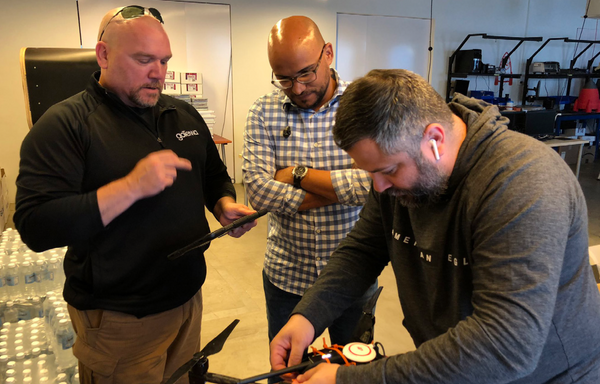LCG Holdings Tests goTenna Pro in Puerto Rico and Achieves 23.1 Mile Single-hop Range
Challenge
During the 2017 Hurricane season, two Category 5 storms — Irma and Maria — struck the U.S. territory of Puerto Rico within a span of a few weeks. Communications infrastructure was badly damaged throughout the island, greatly hindering the immediate disaster response efforts. Status reports from the Federal Communications Commission noted how these failures impacted the recovery process as well — a month after Hurricane Maria’s landfall, 77% of cell sites were still not functional.
With increasingly devastating storms and earthquakes in Puerto Rico, local technology solutions provider LCG Holdings set out to test mesh networking as a redundant and resilient communications alternative for disaster response. Puerto Rico’s mountains, valleys, and dense forests would prove to be a difficult challenge for line-of-sight radio transmissions. The goal of the evaluation was to find a mesh-enabled solution that could send text messages across the longest possible distance in various operating environments.
Solution
In November 2018, LCG Holdings coordinated a mesh networking range test in Puerto Rico using goTenna Pro devices as well as goTenna Pro’s native iOS/Android mobile app. goTenna Pro devices pair with end users’ smartphones using a Bluetooth connection, creating a multi-hop, peer-to-peer mesh network. Even when unpaired to a smartphone, a goTenna Pro device can also serve as a standalone relay node for all other devices in the network — eliminating or reducing the need for fixed base stations or repeaters. goTenna’s mesh networking protocols specifically support low-bandwidth data transmissions such as text messaging, mapping, and location tracking.
After a one-hour product training session, test team members from goTenna, Bonifacio Alvarado School, IBM, and Engine-4 were ready to deploy their goTenna Pro devices and paired mobile apps. In order to simulate a disaster response environment, setup and training were also conducted without relying on cell service or wifi — goTenna supplied a goTenna Pro Deployment Kit, which allows team members to download the app to their phones using an internal hotspot and share network frequencies offline via QR code.

goTenna Pro network setup and training at the Engine-4 coworking space in Bayamón.
Results
During the two-day evaluation, nine goTenna Pro mesh networking devices were distributed across the northeastern part of the island. Each device or “node” in the mesh network was placed in a strategic position to overcome anticipated line-of-sight challenges and maximize transmission range. The test team members and various relay devices were deployed to the following locations:
- Bayamón: One relay device was attached to a drone launched from the Engine-4 office roof approximately 650 feet in the air and two paired devices were held by team members on the ground.
- Orocovis: Four relay devices were placed on the skids and doors of a helicopter flying 400 feet above the Toro Verde mountain range, which has a maximum elevation of 1,079 feet. Another device was paired to the phone of a test team member inside the helicopter for air-to-ground communications.
- San Juan: A final test team member was stationed with one device inside the Governor’s Mansion, serving as the team’s incident command.

The test team successfully sent off-grid text messages from Orocovis to Bayamón in Puerto Rico using a single goTenna Pro mesh network hop — a total distance of 23.1 miles.
Throughout the testing process, every message was successfully transmitted and received without any loss of data. Messages were transmitted between Bayamón and Orocovis as well as between Bayamón and San Juan. For all three testing locations, the near real-time location of each individual user, updated at 30 second intervals, appeared on a shared map in the goTenna Pro app without any data loss. Most notably, the goTenna Pro mesh network exceeded range testing expectations despite the challenging terrain — the longest single-hop range recorded during this particular evaluation spanned a distance of 23.1 miles, from Orocovis to Bayamón.
The success of the range test could have game-changing impacts on the future of disaster response in Puerto Rico. During Hurricane Maria, government agencies relied on a short supply of satellite phones for critical communications. Now, in the event of a likely cell tower failure or even a jammed satellite network, staff within the Governor’s Mansion — a 480-year-old building surrounded by seven-feet thick walls — could still send and receive updates from local leadership and response teams across the island. Even for teams operating within impacted areas, off-grid texting and mapping capabilities ensure constant situational awareness for first responders performing life-saving work and delivering mission-critical supplies.
“If you send a truck of water to a community, you need to see where that truck is. If it goes missing for eight hours, it’s a nightmare because you have people in a town waiting on that water to survive. With the goTenna Pro app, you are able to see your assets at any moment. That’s what you need in the middle of an emergency. ”
Rafael Bobe, Owner
LCG Holdings & Control
This initial range test is only the start of establishing mesh networking alternatives in Puerto Rico. In future tests, LCG Holdings plans to evaluate how multiple mesh network hops can further increase range, ideally connecting San Juan City on the northeast coast of Puerto Rico to Mayaguez on the west coast — an approximately 72 mile distance with the island’s largest mountain range, Cordillera Central, in between. Additional projects on the horizon include the development of semi-permanent goTenna Pro aerial relay nodes throughout the island to ensure rapid deployment ahead of the next disaster.
